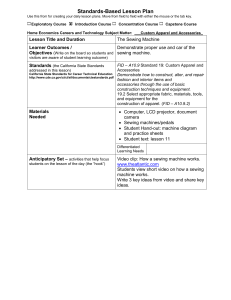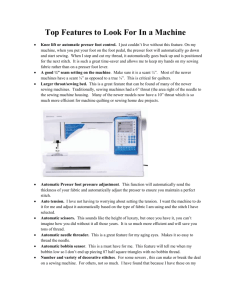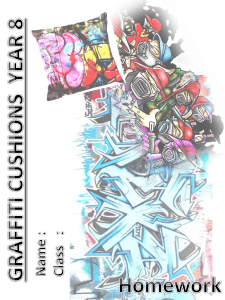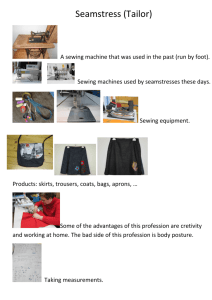Sewing Machines and Sergers Oregon 4-H Clothing Construction Fact Sheets: Sewing machines
advertisement
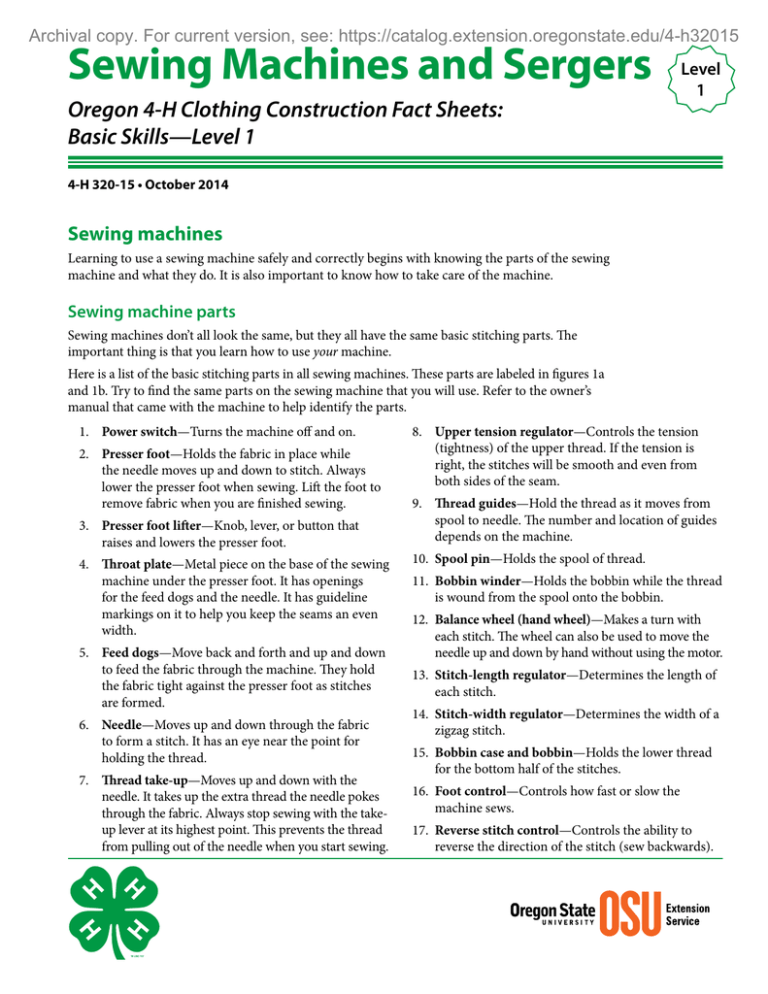
Archival copy. For current version, see: https://catalog.extension.oregonstate.edu/4-h32015 Sewing Machines and Sergers Oregon 4-H Clothing Construction Fact Sheets: Basic Skills—Level 1 Level 1 4-H 320-15 • October 2014 Sewing machines Learning to use a sewing machine safely and correctly begins with knowing the parts of the sewing machine and what they do. It is also important to know how to take care of the machine. Sewing machine parts Sewing machines don’t all look the same, but they all have the same basic stitching parts. The important thing is that you learn how to use your machine. Here is a list of the basic stitching parts in all sewing machines. These parts are labeled in figures 1a and 1b. Try to find the same parts on the sewing machine that you will use. Refer to the owner’s manual that came with the machine to help identify the parts. 1. Power switch—Turns the machine off and on. 2. Presser foot—Holds the fabric in place while the needle moves up and down to stitch. Always lower the presser foot when sewing. Lift the foot to remove fabric when you are finished sewing. 3. Presser foot lifter—Knob, lever, or button that raises and lowers the presser foot. 4. Throat plate—Metal piece on the base of the sewing machine under the presser foot. It has openings for the feed dogs and the needle. It has guideline markings on it to help you keep the seams an even width. 5. Feed dogs—Move back and forth and up and down to feed the fabric through the machine. They hold the fabric tight against the presser foot as stitches are formed. 6. Needle—Moves up and down through the fabric to form a stitch. It has an eye near the point for holding the thread. 7. Thread take-up—Moves up and down with the needle. It takes up the extra thread the needle pokes through the fabric. Always stop sewing with the takeup lever at its highest point. This prevents the thread from pulling out of the needle when you start sewing. 8. Upper tension regulator—Controls the tension (tightness) of the upper thread. If the tension is right, the stitches will be smooth and even from both sides of the seam. 9. Thread guides—Hold the thread as it moves from spool to needle. The number and location of guides depends on the machine. 10. Spool pin—Holds the spool of thread. 11. Bobbin winder—Holds the bobbin while the thread is wound from the spool onto the bobbin. 12. Balance wheel (hand wheel)—Makes a turn with each stitch. The wheel can also be used to move the needle up and down by hand without using the motor. 13. Stitch-length regulator—Determines the length of each stitch. 14. Stitch-width regulator—Determines the width of a zigzag stitch. 15. Bobbin case and bobbin—Holds the lower thread for the bottom half of the stitches. 16. Foot control—Controls how fast or slow the machine sews. 17. Reverse stitch control—Controls the ability to reverse the direction of the stitch (sew backwards). Archival copy. For current version, see: https://catalog.extension.oregonstate.edu/4-h32015 8 10 11 13 7 12 9 14 3 6 17 1 2 5 16 4 15 Figure 1b. Close-up of needle area of sewing machine. Figure 1a. Basic parts of a sewing machine. Care of your sewing machine As with any machine, you need to take good care of your sewing machine to keep it running smoothly. Keep your sewing machine clean, and remove lint often. Wipe the upper parts of the machine with a soft cloth. Use a lint brush to clean the bobbin case and other hard-to-reach parts. After cleaning the machine, ask your leader or parents to help you oil the sewing machine as described in the owner’s manual. Sewing with your sewing machine The best way to become familiar with your sewing machine is to practice using it. It takes time and practice to be able to control the speed of the machine and to stitch straight. The best way to start is to practice sewing on paper. This allows you to see exactly where you are stitching, so you can practice stitching straighter and become more familiar with your machine before you start sewing on fabric. You can use the practice page included in this fact sheet, use a sheet of lined notebook paper (for straight lines), or make your own (by drawing curves or other shapes on plain paper). 2 Oregon 4-H Clothing Construction Fact Sheets Archival copy. For current version, see: https://catalog.extension.oregonstate.edu/4-h32015 Practice on paper: Stitching straight lines Remove the thread from your machine. Position the marked paper under the presser foot, and line up the needle with the lines on the paper. Lower the presser foot using the presser foot lifter. Turn the balance wheel toward you, and gently press on the foot control. Another technique is to practice following the line with the edge of the presser foot. This trains your eye to use the fabric as a guide for straight sewing. Practice on paper: Starting and stopping As the machine begins to stich, remove your hand from the balance wheel. Place it to the right of the needle. Place your left hand to the left of the needle. Use your hands to guide the paper through the machine. You do not need to push or pull on the paper. Instead, just guide it so the stitching follows the line. To stop, release the pressure on the foot control. Turn the balance wheel by hand until the thread take-up is as high as it will go. Practice using your machine until you can put the right amount of pressure on the foot control so the machine runs smoothly at a medium speed and you follow the marked lines. Practice on paper: Stitching curved lines With the thread still removed from the machine, practice some curved lines—both inside and outside curves. Practice stitching along these lines until you are able to guide the paper easily and run the machine smoothly. If you stitch slowly, it will be easier to follow the curves. Practice on paper: Stitching pivots at corners With the thread still removed from machine, practice stitching around corners. Turning corners is called pivoting. Stitch to the corner. Stop the needle when it is down in the paper. Lift the presser foot. With the needle still down in the paper, turn the paper until the presser foot lines up with the next stitching line. Lower the presser foot, and continue stitching. Threading the machine Read the owner’s manual to learn how to thread the machine and wind the bobbin. Use the same kind of thread in both the machine and the bobbin. Learn to do these things: • Wind the bobbin. • Put the bobbin in the case and remove it. • Thread the top of the machine. • Thread the needle. • Bring up the bobbin thread. • Operate the balance wheel (hand wheel). Basic Skills: Sewing Machines and Sergers 3 Archival copy. For current version, see: https://catalog.extension.oregonstate.edu/4-h32015 Stitching on fabric After practicing on paper, you can practice stitching on fabric. It is good to practice stitching on any new fabric you are working with to see how it handles and to test the tension, stitch length, thread color, and needle choice. To practice stitching on fabric, mark straight lines, curved lines, and corners on fabric scraps, and stitch on all of these lines. Follow these general steps: • Set the stitch length to 10 to 12 stitches per inch. • Make sure the upper and bobbin threads are at the back of the machine under the presser foot. • Place the fabric under the presser foot, and lower the presser foot. • Lower the needle into the fabric by turning the balance wheel (hand wheel), and begin stitching. • At the end of each row of stitching, turn the balance wheel until the take-up lever is at is highest point. • Raise the presser foot lifter, and pull the fabric to the back of the machine under the presser foot. • Cut the threads close to the fabric. • Leave 2 to 3 inches of thread tails coming from the machine needle and bobbin. • Check that the stitch tension is balanced and looks the same from both sides of the seam. Try any of these techniques to keep your stitching an even distance from the edge: • Use the straight edge of the presser foot as a guide, keeping it along the fabric edge or a uniform distance from the edge. • Use the lines marked on the throat plate of your machine to guide the fabric. • Place a magnetic or screw-on seam guide on the machine so its edge is the desired distance from the needle. • Place a strip of adhesive or masking tape on the machine so its edge is the desired distance from the needle. 4 Oregon 4-H Clothing Construction Fact Sheets Archival copy. For current version, see: https://catalog.extension.oregonstate.edu/4-h32015 Sergers/overlock sewing machines A serger (also called an overlock machine) is another type of sewing machine. A serger stitches a seam, finishes the raw edges, and cuts off excess fabric all at the same time. Be sure to check the fit of your garment before serging because seam allowances will be too small to make alterations after serging. A serger uses three, four, or even five threads instead of the two threads used in a conventional sewing machine. Serger machine parts Like conventional sewing machines, sergers don’t all look the same, but they all have similar parts. The important thing is that you learn how to use your machine. Here is a list of the basic parts of a serger. These parts are labeled in figures 2a and 2b. Try to find the same parts on the serger that you will use. Refer to the owner’s manual that came with the machine to help identify the parts. 1. Power switch—Turns the machine off and on. 2. Needle threads—Sergers have one or two needle threads, usually referred to as the left and right needle threads. As the needle goes through the fabric, they form a stitch. And at the same time, they catch and secure the two looper threads. 3. Looper threads—Sergers have lower and upper looper threads. The lower looper thread does not stitch through the fabric; it interlocks with the upper looper and is secured by the needle thread. The upper looper also does not stitch through the fabric; it interlocks with the lower looper as it is secured by the needle thread. 4. Stitch finger—Metal prong located on the throat plate or presser foot that stays between the fabric and the thread until the stitch is completely formed. 5. Blades—Knives that trim the seam as it is stitched. 6. Presser foot—Holds the fabric in place while the needle moves up and down to stitch. 7. Presser foot lifter—Knob, lever, or button that raises and lowers the presser foot. 8. Throat plate (cloth plate)—Metal piece on the base of the sewing machine under the presser foot. 10. Looper cover—Keeps fingers away from looper and blade action. 11. Tension dials—Control the tension (tightness) of each individual thread. 12. Telescoping thread guides and holder—Hold the thread as it moves from spools to needle. The pole can telescope up and down depending on the height of the spools or desire to lift the threads. 13. Spool pins—Hold the spools of thread. 14. Spool plate—Holds the spool pins to support the various spools of thread. 15. Balance wheel (hand wheel)—Makes a turn with each stitch. The wheel can also be used to move the needle up and down by hand without using the motor. 16. Stitch-length dial—Determines the length of each stitch. 17. Differential feed control—Controls two sets of feed dogs that work together or at different lengths of strokes. 18. Foot control—Controls how fast or slow the machine sews. (Figure 1 shows socket only.) 9. Needle(s)—Moves up and down through the fabric to form a stitch. It has an eye near the point for holding the thread. There may be one or two needles, referred to as the left and right needles. Basic Skills: Sewing Machines and Sergers 5 Archival copy. For current version, see: https://catalog.extension.oregonstate.edu/4-h32015 2 3 12 13 7 9 16 11 17 8 13 14 4 10 6 5 15 1 Figure 2b. Close-up of needle area of serger. 18 Figure 2a. Basic parts of a serger. Care of your serger Keep your serger clean, and remove lint often. Wipe the upper parts of the machine with a soft cloth. Use a lint brush to clean hard-to-reach parts. After cleaning the machine, ask your leader or parents to help you oil the serger as described in the owner’s manual. Sewing with your serger Start by a forming a thread chain Before you begin serging, you will need a 2-inch (5-cm) thread chain behind the presser foot. To make this chain, hold the looper and needle threads with your left hand and lower the presser foot. Then turn the wheel with your right hand as you lightly press the foot control. Continue pressing the foot control as the thread chain forms. Practice serging Before stitching on a project, always test the serger tension on a scrap of the fabric you are using. Refer to the owner’s manual if the stitch does not look balanced or if the fabric puckers. A serged seam is only 1/4 to 3/8 inch (6 mm to 1 cm) wide. Practice placing your fabric scrap in the serger so the seam is sewn at that position. 6 Oregon 4-H Clothing Construction Fact Sheets Archival copy. For current version, see: https://catalog.extension.oregonstate.edu/4-h32015 Changing threads Changing threads on a serger or overlock machine looks intimidating. But it is a lot easier than it looks. Follow these easy steps: 1. DO NOT REMOVE the threads from the machine. 2. Clip the threads near the thread spools. Remove the spools and replace them with new spools. 3. Tie the new threads to the old threads using a square knot. Make sure the knot is tight by tugging on it. Clip the threads close to the knot. 4. Lift the presser foot, and raise the needles. 5. Write down the tension settings so you can return the dials to the correct setting after you change the threads. Now, loosen all tensions to “0” or the minus (−) numbers. 6. Pull the needle threads through the machine. Cut the threads at the needles, clipping off the knots that join the old and new threads. Rethread the needles. 7. Pull the upper and lower looper threads through the machine. 8. Pull all threads to the left under the presser foot. 9. Return the tensions to their original settings. 10. Hold the threads and press the foot control until a thread chain forms. You are ready to go! Serging techniques There are many references to guide you in using the serger to its fullest potential. Ask your leader for suggestions, and consult these other materials for specific information about serger techniques. References Zieman, N. (1991). Let’s Sew! A Beginner’s Sewing Guide. Beaver Dam, WI: Nancy’s Notions. By Pamela Rose, 4-H Youth Development specialist, family and consumer science and expressive arts, Oregon State University. Photos by Pamela Rose, © Oregon State University. This publication is based on and replaces OSU Extension publication 4-H 92115, The Sewing Machine: 4-H Clothing, Skill Level 1, by Ardis W. Koester, Extension textiles and clothing specialist emeritus; and Barbara J. Sawer, Extension specialist emeritus, 4-H Youth Development; both of Oregon State University. Trade-name products and services are mentioned as illustrations only. This does not mean that the Oregon State University Extension Service either endorses these products and services or intends to discriminate against products and services not mentioned. © 2014 Oregon State University. Extension work is a cooperative program of Oregon State University, the U.S. Department of Agriculture, and Oregon counties. Oregon State University Extension Service offers educational programs, activities, and materials without discrimination based on age, color, disability, gender identity or expression, genetic information, marital status, national origin, race, religion, sex, sexual orientation, or veteran’s status. Oregon State University Extension Service is an Equal Opportunity Employer. Published October 2014. Basic Skills: Sewing Machines and Sergers 7 Archival copy. For current version, see: https://catalog.extension.oregonstate.edu/4-h32015 Practice sheet: Straight lines, curved lines, and corners

